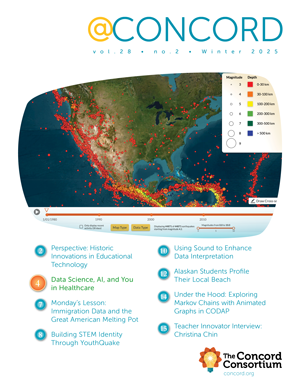News at Concord Consortium
Integrating Language-based AI Across the Curriculum
With partners at Carnegie Mellon University and North Carolina State University, we are developing and researching a novel program that integrates natural language-based artificial intelligence (AI) concepts and practices into high school mathematics, English language arts, and history classes. This new National Science Foundation-funded project builds on the success of our Narrative Modeling with StoryQ project, which developed a web-based text mining and machine learning environment called StoryQ, and embedded the app in curriculum modules to introduce high school students to core AI concepts and AI-powered career opportunities.
Developed as a plugin for CODAP, StoryQ introduces students to machine learning with unstructured text data without coding. StoryQ features dynamically linked data representations that promote meaningful inquiries across tables, graphs, and texts, making machine learning models transparent, explainable, and engaging. Students can use StoryQ to train, test, and troubleshoot text classification models using feature extraction tools and visualizations designed to support young learners and non-computing teachers. A professional development program helps teachers develop the competencies required to implement the modules in a coordinated fashion and offer students coherent learning experiences across disciplines.
We are thrilled to work with the San Joaquin County Office of Education in California and the Maryland Center for Computing Education and with two school districts, one in California and one in Maryland, that serve student populations underrepresented in the field of AI.
Project research is studying how students’ social and disciplinary identities shape their participation in learning of AI knowledge and AI-rich careers, what and how new ideas are generated by teachers as they seek to coordinate their efforts to integrate AI across the curriculum, and to what extent, for whom, and under what conditions the AI Across the Curriculum program supports students to develop knowledge of and interest in AI-rich careers.
Students Write Their Own Data Stories with Story Builder
With pie charts and all manner of graphs, news stories come to us filled with data. As twenty-first century citizens, students must be able to both interpret and create data visualizations. The goal of the National Science Foundation-funded Writing Data Stories project is to help middle school students become “data storytellers,” describing patterns they discover in data and sharing how data help them make decisions in their own lives. The project is a collaboration between the University of California, Berkeley, North Carolina State University, and the Concord Consortium.

We developed the Story Builder plugin for CODAP that allows students to build story “moments,” with each interactive moment capturing the state of the CODAP document at a given time. Students can include text, images, videos, and web pages to create a multimedia presentation. Writing Data Stories curriculum activities include three key features: 1) Data explorations are grounded in students’ everyday experiences and local contexts, 2) Students highlight their own perspectives and experiences through data transformations such as merging datasets, adding new variables, and grouping and filtering data to center questions on the people and places they care about most, and 3) Students learn to tell data stories that describe their rationale, findings, and actions they can take to address socio-scientific issues.
This material is based upon work supported by the National Science Foundation under grant nos. DRL-1949110, DRL-2241669, and DRL-1900606. Any opinions, findings, and conclusions or recommendations expressed in this material are those of the author(s) and do not necessarily reflect the views of the National Science Foundation.
